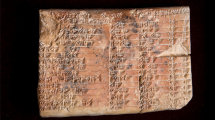Abstract
This column is a forum for discussion of mathematical communities throughout the world, and through all time. Our definition of “mathematical community ” is the broadest. We include “schools ” of mathematics, circles of correspondence, mathematical societies, student organizations, and informal communities of cardinality greater than one. What we say about the communities is just as unrestricted. We welcome contributions from mathematicians of all kinds and in all places, and also from scientists, historians, anthropologists, and others.
Similar content being viewed by others
Notes and references
The artist is Olafur Eliasson. Einar Thorsteinn supplied this information.
All letters to and from Martin Gardner quoted in this article, except Ammann ’s first, belong to the Martin Gardner Papers, Stanford University Archives, and are used here with kind permission.
Gr ünbaum and Shephard preferred the term “aperiodic ” for such tiles. Most authors use the terms “aperiodic ” and “non- periodic ” interchangeably.
John Conway ’s fanciful names —sun, star, king, queen, jack, deuce, and ace —for the seven vertex configurations allowed by Penrose ’s rules seem permanent.
Gr ünbaum and Shephard proved many of Ammann ’s assertions about his tiles; he joined them as co-author of Ammann, R., Gr ünbaum, B., and Shephard, G. C., “Aperiodic Tilings, ”Discrete and Computational Geometry, 1992, vol. 8, no. 1, 1–25.
Martin Gardner ’s chronicles of “Dr. Matrix ” includeThe Incredible Dr. Matrix;The Magic Numbers of Dr. Matrix; andTrapdoors,Ciphers, Penrose Tiles, and the Return of Dr. Matrix.
Heesch ’s problem asks whether, for each positive integerk, there exists a tile that can be surrounded by copies of itself ink rings, but notk + 1. Such a tile hasHeesch number k. Robert Ammann was the first to find a tile with Heesch number 3. Today tiles with Heesch numbers 4 and 5 are known, but the general problem is still unsolved.
Hao Wang, “Proving theorems by pattern recognition. II, ”Bell System Tech. J. 40, 1961, 1–42.
Branko Grünbaum and Geoffrey Shephard,Tilings and Patterns, W. H. Freeman, New York, 1987.
Martin Gardner, “Extraordinary nonperiodic tiling that enriches the theory of tiles, ” Mathematical Games,Scientific American, January, 1977, 110–121.
SeeTilings and Patterns, Chapter 10.6, “Ammann bars, musical sequences and forced tiles, ” pp. 571–580.
See N. G. de Bruijn, “Algebraic theory of Penrose ’s non-periodic tilings of the plane, ”Proceedings of the Koninglike Nederlandse Akademie van Wetenschappen Series A, Vol. 84 (Indagationes Mathematicae, Vol. 43), 1981, 38–66. De Bruijn showed that the construction is really very general. Using n-grids and n-dimensional cubes, for any positive integern, one gets non-periodic tilings of non-Penrose types. In general, the construction gives tilings with many different tiles whose matching rules, if they exist, remain a mystery, but a few very interesting tilings have been found in this way. See, e.g., J.E.S. Socolar, “Simple octagonal and dodecagonal quasicrystals, ”Physical Review B, vol 39, no. 15, May 15, 1989, 10519–51.
See M. Senechal and J. Taylor, “Quasicrystals: the view from Les Houches, ”The Mathematical Intelligencer, vol. 12, no. 2, 1990, 54–64.
Gardner ’s files show that Benoit Mandelbrot met Ammann once in 1980. I had not met Mandelbrot then.
All letters to and from Branko Gr ünbaum, except my letter after meeting Ammann, are used with Gr ünbaum ’s kind permission.
Ammann visited and corresponded with Paul Steinhardt and his students, Dov Levine and Joshua Socolar.
Robert Ammann, “Another Explanation of the Cretaceos-Tertiary Boundary Event, ” unpublished.
For the journalStructural Topology. The editor, Henry Crapo, also wrote to Ammann about this but also received no reply.
Roger Penrose, “Remarks on Tiling, ” in R. Moody (ed.),The Mathematics of Long-Range Aperiodic Order, Kluwer, 1995, p. 468.
loan James, “Autism in Mathematics, ”The Mathematical Intelligencer, vol. 25, no. 4, Fall 2003, 62–65.
Norbert Wiener,Ex-Prodigy, pp. 3–7, 125–142.
Conference, “Geometry of Quasicrystals, ” March 18-22, 1991, ZIF (Center for Interdisciplinary Research), Bielefeld University, Bielefeld, Germany.
Joshua Socolar, “Weak Matching Rules for Quasicrystals, ”Communications in Mathematical Physics, vol 129, 1990, 599–619. It should be noted that Michael Longuet-Higgins ’s “Nested Triacontahedral Shells, or how to grow a quasicrystal, ”The Mathematical Intelligencer, vol. 25, no. 2, Spring 2003, bears no relation to Ammann ’s construction.
See, e.g., P. Kramer and R. Neri, “On Periodic and Non-periodic Space Fillings ofE m Obtained by Projection, ”Acta Crystallographica (1984), A40, 580–587; L. Danzer, “Three dimensional analogues of the planar Penrose tilings and quasicrystals, ”Discrete Mathematics, vol. 76, 1989, 1–7; and L. Danzer, “Full equivalence between Socolar ’s tilings and the (A,B,C,K)-tilings leading to a rather natural decoration, ”International Journal of Modern Physics B, vol. 7, nos. 6 &7, 1993, 1379–1386.
Special Session on Tilings, 868th meeting of the American Mathematical Society, Philadelphia, Pennsylvania, October 12–13, 1991. The American Mathematical Society does not pay honoraria or travel expenses.
At the last minute Coxeter couldn ’t come. They never met.
H. Williams, “Richland Lad, 3, is Wizard at Geography, ”The Herald (Richland, Washington), 1949 (undated clipping). The Ammann family had moved from Massachusetts to Washington while August Ammann, an engineer, worked on a nuclear power construction project there.
Author information
Authors and Affiliations
Corresponding author
Rights and permissions
About this article
Cite this article
Senechal, M. The Mysterious Mr. Ammann. The Mathematical Intelligencer 26, 10–21 (2004). https://doi.org/10.1007/BF02985414
Published:
Issue Date:
DOI: https://doi.org/10.1007/BF02985414




